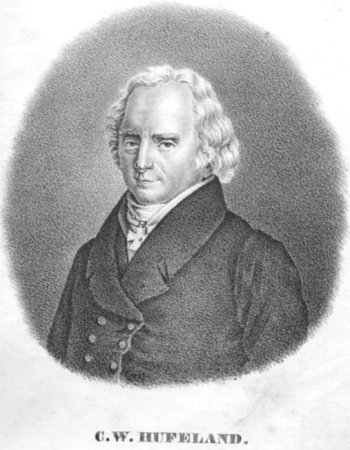Hufeland on Infants
Today, we raise a nineteenth-century child. The University of Houston's College of Engineering presents this series about the machines that make our civilization run, and the people whose ingenuity created them.
An odd little book emerged from between the cracks in a bookcase at home. It's a 130-page instruction manual for mothers of newborn babies. It was published in Switzerland in 1844. While the German is simple, it's written in the hard-to-read old German typeface. This seems to've been the book that my great-grandmother used in Zürich to raise my infant grandfather.
The author is given as Dr. Christoph Wilhelm Hufeland, born in Saxony in 1762. Hufeland is hardly known today, but he was one of the great European doctors of his age. He founded a noted Journal of Medicine and Surgery, and a teaching hospital in Berlin. He was an early student of the new practice of vaccination.
This copy of the book has been modified by an anonymous author from a Hufeland book that'd been in print for almost a half-century. It reflects the world before we knew of germs -- before we even had fever thermometers. And, what did it say about the dangerous business of sustaining early human life, so long ago?
First, advice to the pregnant mother: lay off alcohol, get plenty of fresh air, don't get overexcited, be careful even about reading novels for they can be upsetting, and eat bland food. Today, we know very well that alcohol can endanger an unborn baby. His advocacy of fresh air was a fairly new idea at the time. It made sense when houses were heated by open indoor fires.
One idea, strongly stressed by Hufeland, is washing the new baby daily with cold water, and occasionally with lukewarm water. He also advises that a baby's crying should not be stifled. I suspect much of this had the effect of keeping the child clean and its lungs well exercised. The great scourge of that age was tuberculosis, especially scrofula (or tuberculosis of the lymph glands.) Hufeland's medical research had included a special interest in TB.
He warns mothers not to expect a baby to walk too soon and to avoid the old practice of swaddling a child with tight bindings. He provides his own recipe for a powder that heals colic. He deplores the widespread practice of enema-giving.
Perhaps the most arresting words appear in the author's Foreword. Good health, it says, should be available to rich and poor alike. And this book is, indeed, one of the new breed of inexpensive books, printed on fast presses, bound by the printer, and sold to common folk. This little manual is part of a social equalization process that lay at the heart of the nineteenth century.
As to how much real good this version of Hufeland's medicine did for a worried parent, it's hard to tell. Hufeland himself was just a way station in a long learning process. I suspect the book served primarily to calm the parent coping with a first child -- just as Benjamin Spock calmed my wife and me, so many years ago. Holding this odd little talisman in my hand, I know that it really is a part of the surprising fact that I even exist, today.
I'm John Lienhard, at the University of Houston, where we're interested in the way inventive minds work.
(Theme music)
Guter Rath an Mütter und Kindswärterinnen über die physische Erziehung der Kinder in den ersten Jahren. nach Dr. Ch. W. Hufeland. St. Gallen, Druck von R. Unteregger, 1844. (anon.)
Michaud, J Fr Joseph, Biographie Universelle Ancienne et Moderne. Paris: Madame C. Desplaces, 1854-[65]. See entry under HUFELAND (Christophe-Guillaume).
I am grateful to Jack Hall and Jeff Fadell, both with the UH Library, for their substantial assistance with these old foreign-language sources.

Christoph Wilhelm Hufeland, 1762-1836 (the frontispiece of his book.)